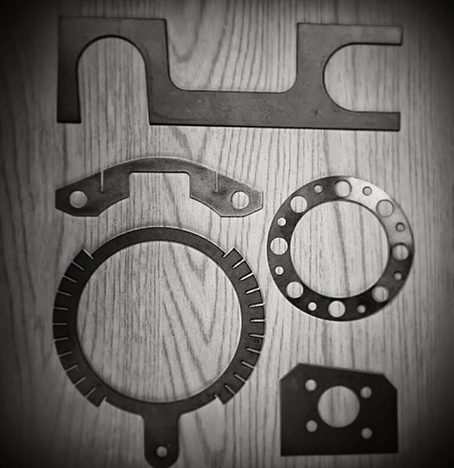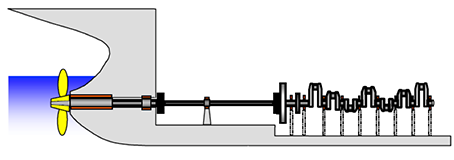Shaft Alignment – Laminated Shims
Published: 11th April 2016
Incorrectly aligned shafts and the consequences of this are behind more than 50 % of all malfunctions in rotating machines. This increases unscheduled downtime and therefore production loses. This, of course, will increase overall maintenance costs. In addition, misaligned shafts increase vibrations and friction, which can increase the energy consumption considerably and cause premature bearing and seal damage.
Rotating machines are usually described according to how they are connected to each other. Most common are horizontally mounted machines, usually a pump and motor. The machines can also be positioned vertically in some circumstances. Another type is offset mounted, or cardan-shaft-coupled machines. These often have some type of drive, for example rollers in a papermaking machine. Often several machines are connected in line, so-called machine trains, for example a gearbox between engine and the driven machine. A modern shaft alignment system can measure all the above types of machine and has important functions that aid the user in obtaining faster and better results.
However carefully machinery foundations are laid there will always be some offset or angular misalignment. To bring them to the correct alignment Shims are needed under the mounts.

Where coupling misalignment exists, the two connecting shafts are forced to rotate in an eccentric way and so cause a number of problems e.g.: –
- Vibration (in shafts and foundation bolts).
- Heat build-up (in shafts and couplings).
- Bearing wear.
- Seal wear.
- Metal fatigue (in shafts, couplings & foundation bolts).
- Increased power consumption (as much as 20% on misaligned units).
(Even in circumstances where flexible couplings are used it has been shown that the same stresses occur in the bearings and shafts either side.)
These above problems inevitably to increased costs, such as: –
- Replacement bearings.
- Replacement seals.
- Extra maintenance and repairs.
- Unplanned machine down time.
- New equipment, long before it would normally be needed.
In support of shaft alignment Ford Component Manufacturing has supplied Shim materials for many years, one of our biggest growth areas being for our Laminated Shim product.
https://www.ford-engineering.com/laminated-products
Recently we were approached by one of our clients in the Marine Industry, asking for advice on an alignment issue between a motor and propeller. He had been told shaft alignment in this situation is typically thought of as nonadjustable! Our answer was “this is not strictly true, you can “shim” in most situations to make sure your shafts and couplings are in very close alignment, to do this use the best available laser technology for measuring runout then shim as necessary, its not easy, but done properly it prevents lots of issues later in the life of the equipment”
The alignment of propeller shafts on ships, tugboats, large pleasure yachts, and other vessels can be done but it is a time consuming and difficult task.
The simplest method would be to use a straight edge and eyesight. This is quick and easy but is not very accurate at all and for most situations it is just not good enough.
The next choice for many years and the best way to align couplings, until recently, was using dial gauges (the Rim & Face or the Reverse Dial method). This is a fairly accurate method if used by a competent trained engineer but it is time consuming and has some drawbacks when compared to the latest alignment methods involving Lasers.
From discussions with some of our clients we understand Laser alignment is now a preferred procedure. Most Laser shaft alignment systems have graphical user interfaces and software packages that do all the complicated alignment calculations for you.
Laser systems can offer many advantages:
- Their beams are dead straight and aren’t affected by gravity or any form of sag.
- Accuracy is built in as the detectors resolution is far greater than the human eye or any mechanical measurement method. In addition human error is almost totally removed from the process.
- Their use eliminates other effects such as coupling eccentricity, or runout. As the Laser targets are rotated to various positions around the rotational centres of the shafts only the rotational centre lines are measured.
- They can be used “Hands Free” as automatic measurements can be taken as the system detects the transmitter position and then takes measurements just as they are rotated into the right position.
- The angle that needs to be swept to get a reading can be varied and can start from any position. This allows readings to be taken when restrictions exist (such as pipes) that prevent large rotations.
- Their transmitters and receiver are often fitted with Bluetooth wireless communication systems allowing very easy remote measurements. No trailing wires getting in the way. This allows alignment of difficult to reach equipment from a safe position.
- The Laser shaft alignment systems have amazing software applications to calculate extremely accurate values for shimming and horizontal corrections.
It is at this point Ford Component Manufacturing shim products are provided. Our accurate shim profiles are made to precise thicknesses. Once we had the dimensions of our client requirement the items were made, delivered to site, on a tight time timeframe for final assembly of the shim under the drive system providing the correct alignment for our clients propeller drive shaft.

Commissioning of the vessel went without any issues, the comment from our client were “vibration was minimal” the Laser Technology and Ford Component Shim sets working together to provide the solution.

